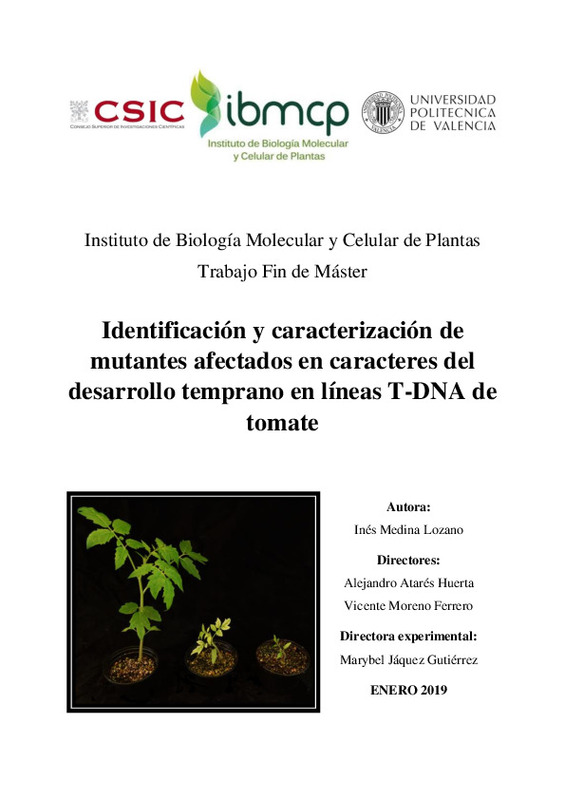|
Resumen:
|
[ES] El tomate es uno de los cultivos hortícolas más importantes a nivel económico y constituye una especie modelo en investigación, especialmente dentro de las dicotiledóneas con frutos carnosos. Por estas razones, la ...[+]
[ES] El tomate es uno de los cultivos hortícolas más importantes a nivel económico y constituye una especie modelo en investigación, especialmente dentro de las dicotiledóneas con frutos carnosos. Por estas razones, la identificación de los genes implicados en el desarrollo de la planta es clave, tanto a nivel aplicado como a nivel de investigación básica. La detección de mutantes afectados en este desarrollo es la mejor estrategia para abordar este objetivo. Para generar colecciones de mutantes, la mutagénesis insercional con T-DNA constituye una herramienta muy útil. Tras conseguir una colección de mutantes, permite el etiquetado de los genes afectados con un inserto de ADN conocido, cuya clonación mediante técnicas basadas en la PCR es rápida y sencilla. Además, si se utilizan trampas génicas se puede obtener información adicional sobre la función del gen a partir del estudio de su patrón de expresión.
En el marco de distintos proyectos de investigación se ha generado una colección de unas 7800 líneas T-DNA de tomate y especies silvestres relacionadas gracias al desarrollo de protocolos eficaces de transformación genética en estas especies. Para la identificación de las líneas mutantes se han utilizado técnicas de cultivo in vitro, junto con el cultivo de plantas en el invernadero. A partir de los mutantes identificados se ha clonado una serie de genes relacionados con el desarrollo vegetativo y reproductivo y la tolerancia a distintos estreses abióticos.
En el presente trabajo se ha planteado un objetivo doble: por un lado, la identificación de nuevos mutantes alterados en la respuesta morfogenética in vitro, así como en caracteres del desarrollo temprano y, por otro lado, la caracterización de mutantes compactos previamente identificados en el grupo. Tras el escrutinio de 80 líneas T-DNA, se ha conseguido la identificación de tres nuevos mutantes con un sistema radicular dañado y/o clorosis. Además, tras el estudio de 15 líneas candidatas, se ha caracterizado un mutante compacto previamente identificado. En las cuatro líneas estudiadas la mutación fue de carácter monogénico recesivo, se integró un único inserto de T-DNA y en ningún caso hubo cosegregación entre el fenotipo mutante y dicho inserto de T-DNA. En todos los casos se están llevando a cabo las tareas necesarias para lograr identificar el gen alterado mediante técnicas de mapeo por secuenciación.
[-]
[EN] Tomato is one of the most important crops at the economical level and it has become a model species in research, especially for dicots with fleshy fruit. For these reasons, one of the keys of the success is the ...[+]
[EN] Tomato is one of the most important crops at the economical level and it has become a model species in research, especially for dicots with fleshy fruit. For these reasons, one of the keys of the success is the identification of genes involved in plant development, both at applied level and in basic research. The best strategy to achieve this objective is the detection of mutants which are affected in this development. In order to obtain mutant collections, insertional mutagenesis using T-DNA is a very useful tool. After generating a mutant collection, it allows the tagging of the affected genes with a known DNA insert, whose cloning using PCR-based techniques is fast and simple. Furthermore, if gene traps are used, additional information about the function of the gene can be obtained from the study of its expression pattern.
Within the context of different research projects, a collection of about 7800 T-DNA lines of tomato and related wild species has been obtained thanks to the development of efficient genetic transformation protocols for these species. In order to identify the mutant lines, in vitro culture techniques have been used, together with the growth of plants in the greenhouse. A series of genes have been cloned related to vegetative and reproductive development, and the tolerance to different abiotic stresses from the identified mutants.
In this work, a double objective has been proposed: on the one hand, the identification of new mutants altered in the morphogenetic response in vitro, as well as in characteres implied in early development and, on the other hand, the characterization of compact mutants previously identified in the group. After the screening of 80 T-DNA lines, the identification of three new mutants with a damaged root system and/or chlorosis has been achieved. In addition, after the study of 15 candidate lines, a previously identified compact mutant has been characterized. In the four studied lines, the mutation had a recessive monogenic nature, a single T-DNA insert was integrated and in no case there was a cosegregation between the mutant phenotype and this T-DNA insert. In all cases, the necessary tasks are being carried out to identify the altered gene by sequencing mapping techniques.
[-]
|







